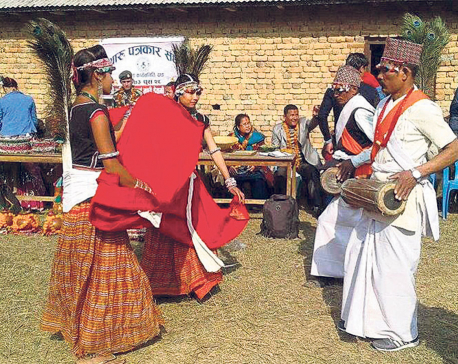
OR
Sickle Cell anemia rampant among Tharus in Western Terai, 11% of the indigenous community have the disease
Published On: January 17, 2021 08:43 AM NPT By: Republica | @RepublicaNepal

KATHMANDU, Jan 16: Sickle cell anemia, a hereditary disease, is rampant in the Tharu community of western Tarai, according to a government research.
The research conducted by Nepal Health Research Council (NHRC) shows that 11 percent of the Tharu people in Western Terai have the sickle cell disease.
“In this condition, patients’ red blood cells become stiff and sickle shaped due to mutation. This condition is a major health threat for Tharus living in western Tarai districts,” Dr Megnath Dhimal, senior research officer at the NHRC, told Republica.
“The disorder, also known as sickle-cell anemia, is a common genetic condition due to hemoglobin disorder, the molecule in red blood cells that delivers oxygen throughout the body. It is caused by a mutation in the hemoglobin gene causing a single amino acid substitution at position 6 of the beta globin molecule (B 6 Gluval, valine or glutamic acid replacement) leading to a structural variant of normal adult hemoglobin (Hba), namely sickle hemoglobin (HBS)12,” according to the NHRC.
The Council had conducted the research among 20,000 Tharu people in Bardiya district of Western Terai.
Of the researched people, 2,111 (10.6%) of the participants were found to have inherited sickle cells from their parents. The condition of inheriting sickle cells from parents is called “Sickle cell trait”. “It is a condition, in which one does not usually have any symptoms of sickle cell disease. People who have sickle cell trait can develop sickle-shaped hemoglobin, but they do not develop sickle cell anemia,” he said.
People having the sickle cell disease have frequent fever, headache, body pain, extremities, and joint pain. Of the participants having SCD, 46.2 % complained of frequent fever and 37.2 percent complained of having headache. Likewise, 37.2 % participants complained of extremities (hand and foot syndrome) and 33.1% complained of joint pain.
“Those having SCD can not be completely treated for the disease. One having SCD should take medications for symptoms developed after having the disease,” Dr Dhimal said.
According to NHRC, a massive awareness campaign should be made to prevent SCD. “Genetic testing and pre-natal service including genetic counseling guidelines should be made for counseling of specific age group populations at risk of SCD,” the research has concluded.
“If the couple is from the same community, they need to go through a blood test before getting married. This will help to prevent the spread of disease to other communities,” Dr Dhimal said.
You May Like This

Maghi festival being observed with fanfare; selection of Bhalmansa ongoing
KANCHANPUR, Jan 15: The people in the Tharu community, mostly from Dang to Kanchanpur in west Nepal, are observing Maghi,... Read More...

Maghi Festival begins at Tuindikhel from Saturday
KATHMANDU, Jan 14: The Maghi Festival-2079, national festival of Tharu community, is going to be organized at Tudikhel from Saturday. Read More...

In Pictures: Tharu people celebrate Sama-Chakeva festival
KATHMANDU, Nov 8: People from the Tharu community have celebrated Sama-Chakeva, a festival that marks the affectionate brother-sister relationship, today... Read More...




Just In
- Weather expected to be mainly fair in most parts of the country today
- 120 snow leopards found in Dolpa, survey result reveals
- India funds a school building construction in Darchula
- Exploring opportunities and Challenges of Increasing Online Transactions in Nepal
- Lack of investment-friendly laws raises concerns as Investment Summit approaches
- 550,000 people acquire work permits till April of current fiscal year
- Fixing a win by outlawing dissent damages democracy
- MoHP cautions docs working in govt hospitals not to work in private ones












_20220508065243.jpg)
Leave A Comment